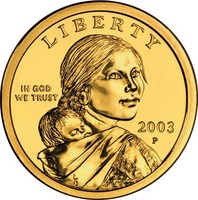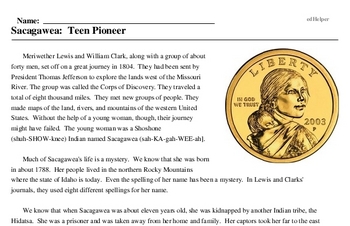Sacagawea: Teen Pioneer
Meriwether Lewis and William Clark, along with a group of about forty men, set off on a great journey in 1804. They had been sent by President Thomas Jefferson to explore the lands west of the Missouri River. The group was called the Corps of Discovery. They traveled a total of eight thousand miles. They met new groups of people. They made maps of the land, rivers, and mountains of the western United States. Without the help of a young woman, though, their journey might have failed. The young woman was a Shoshone (shuh-SHOW-knee) Indian named Sacagawea (sah-KA-gah-WEE-ah].
Much of Sacagawea's life is a mystery. We know that she was born in about 1788. Her people lived in the northern Rocky Mountains where the state of Idaho is today. Even the spelling of her name has been a mystery. In Lewis and Clarks' journals, they used eight different spellings for her name.
We know that when Sacagawea was about eleven years old, she was kidnapped by another Indian tribe, the Hidatsa. She was a prisoner and was taken away from her home and family. Her captors took her far to the east of her home.
When Lewis and Clark's Corps of Discovery reached North Dakota, winter was coming. The Mandan Indians welcomed the white men. They allowed them to build a fort in which to spend the winter.
One day, Toussaint Charbonneau (Two-SAN shar-bone-OH) and Sacagawea came to visit Lewis and Clark. By this time, Sacagawea was about sixteen. Charbonneau may have bought Sacagawea from the Indians. He may have won her gambling. She was more like a slave to Charbonneau than his wife.
Lewis and Clark decided to hire Charbonneau as an interpreter. Sacagawea would come with them. Lewis and Clark knew they would need horses to cross the Rocky Mountains. The Shoshone lived there. Sacagawea could speak Shoshone. She could translate it to Hidatsa, another Indian language that Charbonneau spoke. He would translate it to French. Another man with the Corps of Discovery named Labiche (La BEESHE) would translate the French to English so that Lewis and Clark would understand.
In April 1805, the Corps of Discovery set off across the North Dakota plains. Sacagawea and Charbonneau walked with them. Sacagawea carried her two-month-old baby boy on her back. His name was Jean Baptiste (zhaun bap-TEESTE). Everyone called him "Pomp."
Sacagawea helped Lewis and Clark in many ways. She knew which plants and berries were good to eat. She knew how to make medicines from some of them. Once when a boat capsized, Sacagawea knew what to do. She stayed calm. She picked up the papers and supplies from the water. She saved records of the trip that would have been lost. Lewis and Clark named a river in what is now the state of Montana for her.
As the Corps of Discovery neared the Rocky Mountains, they knew they needed horses to cross. Sacagawea remembered landmarks from when she was a child there. She guided Lewis and Clark toward the Shoshone tribe. When they did meet the Shoshone, Sacagawea realized that the chief was her brother! They had a tearful and happy reunion.




